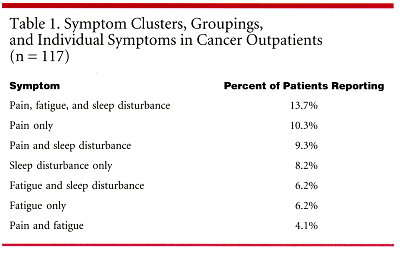Symptom Clusters or Groupings Are Common in Cancer Outpatients
SAN FRANCISCO-More than one-third of cancer outpatients report two or more symptoms such as pain, fatigue, nausea, depression, and sleep disturbances. Because severity of individual symptoms and risk of clinical depression both worsen as the number of symptoms increases, these symptom clusters or groupings have important clinical implications, according to Marylin J. Dodd, RN, PhD, professor of nursing at the University of California at San Francisco.
SAN FRANCISCOMore than one-third of cancer outpatients report two or more symptoms such as pain, fatigue, nausea, depression, and sleep disturbances. Because severity of individual symptoms and risk of clinical depression both worsen as the number of symptoms increases, these symptom clusters or groupings have important clinical implications, according to Marylin J. Dodd, RN, PhD, professor of nursing at the University of California at San Francisco.
Dr. Dodd reported data from a cross-sectional, descriptive study of symptoms and comorbidities in 177 oncology patients recruited from three outpatient settings. "The traditional approach to studying symptoms has been to perform detailed assessments of individual symptoms," she said. "However, clinical experience suggests that oncology outpatients present with multiple symptoms and a variety of comorbid conditions. The purposes of this study were to determine the prevalence of pain, fatigue, and sleep disturbances in a sample of oncology patients and to determine the prevalence of a number of common comorbid conditions." The study was funded by the National Cancer Institute, Purdue Pharmaceutical, and Janssen Pharmaceutical.
Patient Assessments
The average patient in the study population was 59.4 years old, female, and had a Karnofsky score of 77.2. Patients were assessed using the Wisconsin Brief Pain Inventory (BPI), the Lee Fatigue Scale (LFS), the General Sleep Disturbance Scale (GSDS), the Center for Epidemiological Studies Depression Scale (CES-D), and a checklist of common medical conditions.
Analysis of symptom groupings showed that fatigue and sleep disorders both increased in prevalence and in severity as the number of symptoms the patient reported increased. Worst reported pain levels were significantly higher in patients with three or more symptoms compared to those with only one symptom, and depression similarly increased as number of symptoms increased from one to three.
Although 41.9% of the patients in this sample reported no symptoms, 34% reported two or more symptoms (see Table 1).

High Rate of Comorbidities
Cancer patients also had a high incidence of comorbidities. The most common were back problems (61.3%), allergies (58.5%), headaches (50.5%), hemorrhoids (46.3%), arthritis (33.3%), and hypertension (30.4%).
"About 35% of our outpatients have two or three symptoms. We found that as the number of symptoms increased, the severity of each increased, as did depression. Patients should be assessed for multiple symptoms and for comorbidity," Dr. Dodd suggested.
An unsolved problem is how to repeatedly assess multiple symptoms with the least burden to the patient. "We also need to test interventions targeting one symptom and determine their impact on the symptom cluster," Dr. Dodd said. "For example, we should look at the effect of exercise not only on fatigue but also on pain, depression, and sleep."